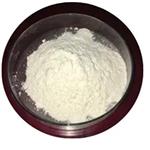Special breakfast foods and other cereals and
foods, cattle food, adhesives, production of certain
amino acids.
Wheat Gluten is the water-insoluble complex protein fraction sepa-
rated from wheat flours. gum gluten is wheat gluten in its freshly
extracted wet form. dry gluten is approximately 70–80% protein
but is deficient in the amino acid lysine. it absorbs two to three
times its weight in water. the differences in properties of wheat glu-
ten in comparison to almost all other food proteins are largely due
to the low polarity level of the total amino acid structure. most food
proteins have polar group levels of 30–45% and have a net negative
charge, while wheat gluten has a polar group level of approximately
10% with a net positive charge. this results in the repulsion of excess
water and the close association of the wheat gluten molecules and
resistance to dispersion. in baked goods, this results in the ability to
form adhesive, cohesive masses, films, and three-dimensional net-
works. gluten formation is utilized in the baking industry to impart
dough strength, gas retention, structure, water absorption, and
retention with breads, cakes, doughnuts, and so on. it is also used as
a formulation aid, binder, filler, and tableting aid. see gluten;
vital wheat gluten.
Gluten is a protein complex formed when water is kneaded with
wheat flour which brings about the removal of a large portion of the
starch. it forms the elastic framework of dough, entrapping the gas
produced by the fermentation of leavening action which results in
a risen dough of desired loaf volume and structure. gliadin is of
lower molecular weight and provides extensibility as compared to
glutenin, which is of higher molecular weight and contributes elas-
ticity. gluten is available as wheat gluten, corn gluten, and zein.
vital wheat gluten is the most widely used. see wheat gluten.
A mixture of many proteins in which gliadin, glutenin, globulin, and albumin predominate; it occurs in highest percentage in wheat (Manitoba wheat contains approximately 12%) and also
to some extent in other cereal grains, usually associated with starch.
Gluten forms the chief storage protein fraction in a mature wheat grain. Gluten proteins can be divided into three main groups: high molecular weight glutenin subunits (HMW-GS), low molecular weight glutenin subunits (LMW-GS), and gliadins. Gluten has a great impact on the quality of a whole range of cereal-based foods.
Gluten exhibits visco-elastic properties, which helps in preparing synthetic cheese with the texture and eating quality of natural cheese. It helps in fortifying low-protein bread flours. Gluten is majorly used in non-bakery foods as a me at replacement in vegetarian foods. It is also used in the production of seafood and crab analogs. Vital whe at gluten has a unique visco-elastic property th at enhances dough strength, mixing tolerance, and handling properties.
When heated to
decomposition it emits acrid smoke and
irritating fumes.


